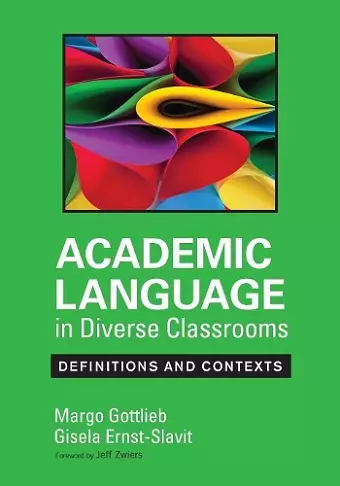Academic Language in Diverse Classrooms: Definitions and Contexts
Margo Gottlieb author Gisela Ernst-Slavit author
Format:Paperback
Publisher:SAGE Publications Inc
Published:5th Jun '14
Should be back in stock very soon

Ensure your school speaks the language of success!
With the rigorous content of College and Career Readiness standards, academic language use has moved to the forefront of educational priorities. School leaders and teachers must ensure that academic language becomes the focus of new curricula, instruction, and assessment, with special attention to linguistically and culturally diverse students.
The author’s six-book series on academic language is already the definitive resource on the topic. This companion volume provides a concise, thorough overview of the key research concepts and effective practices that underlie the series. Including:
- Definitions and examples of the dimensions of academic language.
- A step-by-step template to incorporate academic language use into plans for student learning.
- Graphic models that illustrate the construct of academic language and its classroom application.
Language is the most fundamental building block of education. Be sure your school is as strong as it can be with this indispensable book.
"This book brings language learning in the classroom alive! Against a backdrop of new standards, the authors skillfully take the reader through detailed vignettes of classroom practice that support students’ development of academic language, while at the same time discussing why the practice is effective."
—Margaret Heritage, Assistant Director for Professional Development
National Center for Research on Evaluation, Standards and Student Testing (CRESST) at UCLA
"This book brings language learning in the classroom alive! While there is plenty of theory and research to ground the practices the authors describe, this is not a dry book about language learning. Against a backdrop of new standards, the authors skillfully take the reader through detailed vignettes of classroom practice that support students’ development of academic language, while at the same time discussing why the practice is effective. For those who are interested in learning more about academic language and how to help students develop it, this book is a must read."
-- Margaret Heritage, Assistant Director for Professional Development"This detailed and richly exampled book provides a comprehensive framework for both pre-service and practicing teachers to dig deeply into the nature and development of the language skills necessary for academic success. It emphasizes the need to move beyond a narrow conception of academic language as vocabulary words to an exploration of the nature of instructional and assessment practices that develop language and thinking at the conceptual and discourse levels. The classroom-based examples from across the curriculum, including the arts and physical education, illuminate the nature of the language demands unique to and common across each discipline. I highly recommend this book as a vital tool to guide curriculum planning and renewal at every level." -- Nancy Commins, Clinical Professor
"Academic Language weaves content and language teaching as a focus for designing viable units of learning throughout the school year. By providing students with linguistic tools to understand and use academic content, it enhances their opportunities to meet the rigor of the Common Core State Standards and the Next Generation Science Standards. The authors offer explicit examples of how to build students’ language development using a framework with clear learning targets that lead to effective teaching practices."
-- Janeen A. Kelly, Director of Department of ELL/WL"This book provides a promising vision on how to teach academic language to diverse learners including English Language Learners (ELLs). The authors present a comprehensive framework that combines learning content and language in ways that engage students to learn key ideas and concepts, link concrete knowledge and abstract knowledge, and promote critical thinking. The specific steps on how to create differentiate language objectives for ELLs at different levels of English language proficiency is particularly helpful. I highly recommend this book for general education and English as-a-second language teachers who work as a team to provide effective instruction for diverse learners."
-- Maria del Rosario (Charo) Basterra, Deputy DireISBN: 9781452234786
Dimensions: unknown
Weight: 490g
256 pages